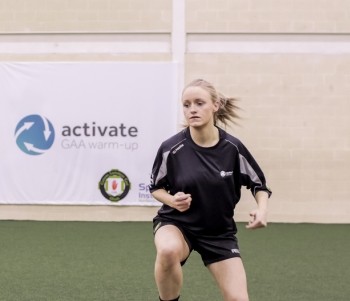By Chris McNicholl and Philip Glasgow
Association of Chartered Physiotherapists in Sport and Exercise Medicine (ACPSEM) (UK Physios in Sport) blog series
Gaelic football and hurling are among the largest participation team sports in Ireland with regular participation from over ¾ of a million people (male and female). Non-contact ACL injuries are a common and difficult problem in field sports, especially among football codes. Recently, the Sports Institute Northern Ireland (SINI) and the Ulster Gaelic Athletic Association (GAA) launched an Injury Prevention Warm Up (activategaa.sini.co.uk ) aimed at reducing occurrence of non-contact ACL and lower limb injuries: “Activate” the Warm Up is the end product of a collaborative project to reduce what appears to be the increasing problem of ACL injuries.
 Using Caroline Finch`s Tripp model1 (Translating Research into Injury Prevention Practice) as a framework, a working group was established to produce a strategy to reduce ACL injuries. This group included elite coaches, orthopaedic knee surgeons, medical staff working with teams and representatives of the GAA. They considered incidence and aetiology of ACL injuries in GAA athletes2 as well as important contextual and sport-specific factors that may influence the effectiveness of an injury prevention programme. The working group agreed that an injury prevention warm-up was the best approach in order to facilitate effectiveness to the wider GAA population. They also recognised that this programme needed to be coach led and embedded in normal training practices.
Using Caroline Finch`s Tripp model1 (Translating Research into Injury Prevention Practice) as a framework, a working group was established to produce a strategy to reduce ACL injuries. This group included elite coaches, orthopaedic knee surgeons, medical staff working with teams and representatives of the GAA. They considered incidence and aetiology of ACL injuries in GAA athletes2 as well as important contextual and sport-specific factors that may influence the effectiveness of an injury prevention programme. The working group agreed that an injury prevention warm-up was the best approach in order to facilitate effectiveness to the wider GAA population. They also recognised that this programme needed to be coach led and embedded in normal training practices.
Modelled on the successful FIFA 11+ programme, the working group designed a sport specific warm up. Initial versions of the warm-up were trialled by athletes and coaches and refined several times to ensure the final product worked in a real-world setting. The programme was designed in a way that involved no equipment, made it simple to learn and carry out, yet was dynamic in nature and included use of the ball. GPS and heart rate data were acquired during the development phase to analyse total running distances and exercise intensity. To ensure symmetry of movement patterns across the warm up, the research team completed inertial movement analysis (IMA).
Like previous successful ACL prevention programmes, the Activate Warm Up focuses on enhancing neuromuscular control, running mechanics, ability to change direction, land from a jump and decelerate. On training nights athletes also complete a circuit of exercises to enhance trunk and leg strength, single leg balance and lower limb plyometrics.
The team developed an implementation strategy, recognizing that any injury prevention warm-up will only be effective if it is carried out regularly, and learning from adherence issues in other sports3 The strategy includes: coaching resources, integration into sporting body coach education programmes, grassroots coaching workshops, as well as a media campaign.
As part of the launch of the programme, Dr Mario Bizzini of FIFA`s Medical Research Centre delivered a keynote lecture to over 300 coaches at the Ulster GAA’s annual conference on the benefits of regularly completing injury prevention warm ups on incidence of lower limb injury and team success. This was extremely well received and over 130 coaches took part in an additional workshop outlining the details of the Activate GAA Warm Up.
In the first 6-weeks following the launch of the programme, the website (activategaa.sini.co.uk) had over 20,000 hits, there was significant press and television coverage and over 500 coaches had taken part in practical workshops. This initial response suggests that the roll out strategy has reached and engaged coaches; however the long-term effectiveness of the programme will be assessed by SINI over the coming years to determine this programmes successfulness in reducing common GAA injuries.
References
1) Finch. C 2006. A new framework for research leading to sports injury prevention. Journal of Science and Medicine in Sport
2) Murphy. J et al 2012. Incidence of Injury in Gaelic Football. A 4-Year Prospective Study. American Journal of Sports Medicine.
3) Soligard T et al 2010. Compliance with a comprehensive warm-up programme to prevent injuries in youth. British Journal of Sports Medicine
******************************************
Philip Glasgow is the Head of Sports Medicine at the Sports Institute of Northern Ireland
Chris McNicholl is a Sports Physiotherapist at the Sports Institute of Northern Ireland